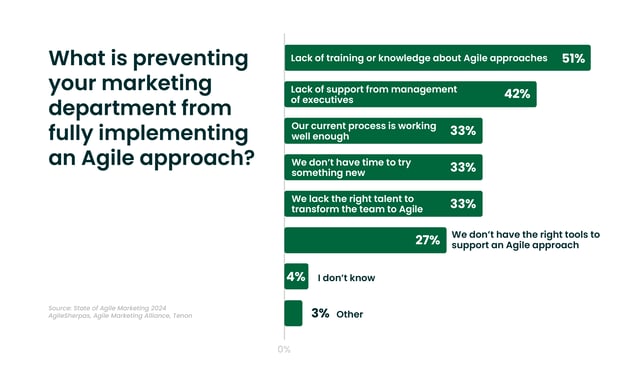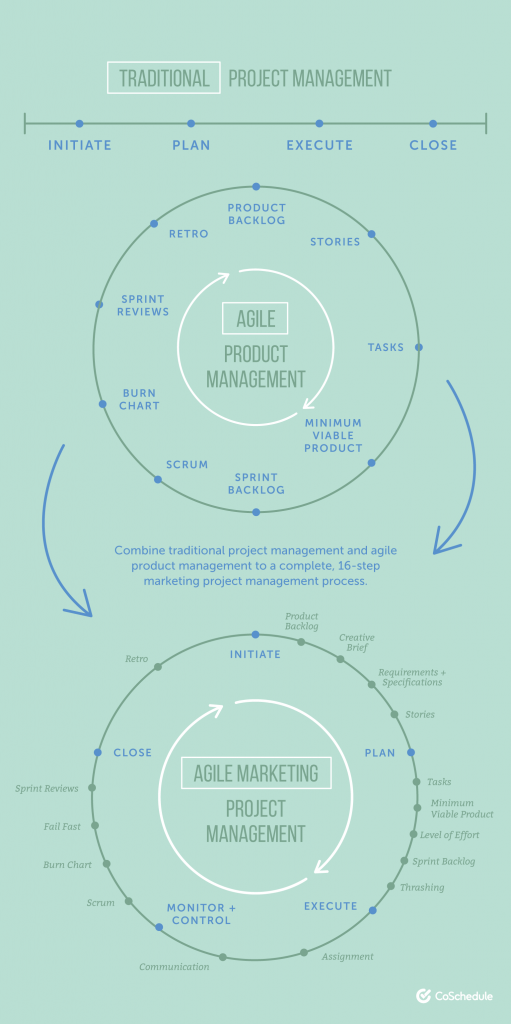-
- marketing agility
- Teams
- Organizations
- Education
- enterprise
- Articles
- Individuals
- Transformation
- Solution
- Leadership
- Getting Started
- business agility
- agile management
- going agile
- Frameworks
- agile mindset
- Agile Marketing Tools
- agile marketing journey
- organizational alignment
- Agile Marketers
- People
- Selection
- (Featured Posts)
- strategy
- agile journey
- Metrics and Data
- Kanban
- Resources
- Why Agile Marketing
- agile project management
- self-managing team
- Meetings
- Scrum
- agile adoption
- scaled agile marketing
- tactics
- scaled agile
- AI
- Agile Meetings
- agile marketing training
- agile takeaways
- Agile Leadership
- agile coach
- enterprise marketing agility
- Scrumban
- state of agile marketing
- team empowerment
- Intermediate
- agile marketing mindset
- agile marketing planning
- agile plan
- Individual
- Team
- Videos
- agile marketing
- kanban board
- Agile Marketing Terms
- agile transformation
- traditional marketing
- FAQ
- agile teams
- Agile Marketing Glossary
- CoE
- Scrumban
- agile
- agile marketer
- agile marketing case study
- agile marketing coaching
- agile marketing leaders
- agile marketing methodologies
- agile marketing metrics
- agile pilot
- agile sales
- agile team
- agile work breakdown
- cycle time
- employee satisfaction
- marketing value stream
- marketing-analytics
- remote teams
- sprints
- throughput
- work breakdown structure
- News
- agile brand
- agile marketing books
- agile marketing pilot
- agile marketing transformation
- agile review process
- agile team charter
- cost of delay
- hybrid framework
- pdca
- remote working
- scrum master
- stable agile teams
- stand ups
- startups
- team charter
- team morale
- user story
- value stream mapping
- visual workflow

Imagine you’re all in on Agile marketing.
You know your current processes aren’t working. The team’s tired of those broken processes making everyone’s jobs unnecessarily difficult. They're undermining your success, and by extension, your company’s success. As someone who likes having a job, that isn’t good.
So, getting your team to go Agile should be easy, right? If the problems you’re facing are out in the open, and it’s clear that Agile can solve them, you'd assume everyone could move forward without hurdles.
Not so fast.
It turns out that getting people to change can be tough. Changing an entire team can be even tougher. But it can be done, and when the potential reward for doing so is producing better work (and feeling better about it, too), the effort is worthwhile.
Before Going Agile, Know Change Management
The status quo is Agile marketing’s greatest enemy.
Even if your current processes have clear problems, that may not be enough to convince the team to make a change. When things have been done one way long enough, it’s easy to get comfortable with things as they are. Imagining how much better they could be can feel like a huge mental leap.
Chalk it up to a quirk in human psychology, but sometimes, we’d rather suffer than put in the work to improve our situation.
Fortunately, this also means that once your team builds better habits, Agile marketing becomes second nature. Here’s how to start the conversation that will put you on the path to success.
Equip Yourself With Some Stats
Marketers love numbers. Especially big numbers that quantify bold promises. After all, it’s not stereotypical marketing fluff if the data proves your position is correct.
In its 7th Annual State of Agile Marketing Report, AgileSherpas discovered the following about agile marketing:
- 40% of traditional marketers plan to adopt Agile within the next year.
- 33% struggle in switching to Agile because current processes are “good enough.”
- Agile marketers said improving customer experience (57%), becoming more competitive in their industry (53%), and increasing organizational alignment to business goals (50%) were the top three most important reasons for making the switch.

Now, here’s a real kicker: additional research shows Agile marketers are 252% more likely to report success. That’s nothing to shake a stick at.
Collectively, these statistics tell you a few things:
- Modern marketers increasingly see Agile as the way forward.
- Staying productive and flexible in the face of rapid business change are key drivers.
- Data shows Agile helps marketing teams achieve success more consistently.
That’s plenty of fodder to help build your case. And next, we’ll explore exactly how to do this.
But, before you learn the 1st step to convince your team to adopt Agile, why don't you take a second and get our Agile Marketing Quick Start Guide?
Step 1: Build Urgency Around a Shared Goal
Any new initiative will need a goal for the team to work toward. Without one, you’re liable to drift without direction, rendering your attempts to adopt agility ineffective.
Plus, goals are powerful motivators for teams. When you set a time-bound target to hit, you create urgency to achieve that outcome.
Here’s an example. Say a team wants to reduce time spent creating a single piece of content by 30%. They also want to do this within 90 days. This team now has:
- A clear and unambiguous target to reach.
- A limited (yet reasonable) amount of time to achieve the goal.
Plus, that’s also an example of a goal Agile can help make happen.
Follow this process to do this yourself:
- Determine your goal. What is it you’re hoping Agile will help you achieve?
- What’s the first step toward achieving that goal? Just one small thing to start with.
- Communicate the value of hitting that goal. “If we achieve [GOAL], we’ll reduce [PROBLEM]” is a great way to frame your message.
Know How Your Goal Will Eliminate Pain
That third point is particularly important for making the first two work. People are more motivated by eliminating pain or avoiding loss than they are by achieving any specific positive outcome.
That sounds counterintuitive, but psychology tells us that’s how we operate.
To understand how that principle works, consider this scenario. You tell your team, “Hey, if we adopt Agile marketing, we can be 252% more successful!”
That’s awesome, but your team is going to need more motivation than that to act. That’s because lots of things make lots of promises to marketers. They need that kind of statistical proof, sure, but they also need to know what specific problems a solution will, well, solve.
Here are some ideas to frame the conversation in a way that highlights pain points being removed:
- Instead of “We’ll collaborate more efficiently,” try something like, “You won’t have to put up with last-minute requests because you didn’t know a task or project was coming up.”
- Rather than, “The team will save time,” you might make your point more effectively by saying, “You’re not going to need to pull so many late nights anymore.”
- Try changing “Our work will improve,” to “Our team is going to feel better about the results we achieve
In each of these examples, instead of offering a benefit, you’re tying an outcome to a specific problem they won’t have to tolerate anymore. That’s a powerful combination for getting buy-in.
Step 2: Make it Easy to Take Action
Now that everyone is starting to get on board, it’s time to put a plan into place.
However, Agile marketing is complex. It incorporates a number of phases, concepts, and tactics that make up its principles, values, and best practices.
That can make moving forward feel intimidating. If no one in your organization has heard of Agile before, they’ll probably feel overwhelmed. Even if they are familiar, they might still feel stressed about the idea of actually implementing it.
So, make it easy to take action.

For each step in implementing Agile marketing, give yourself a deadline to incorporate each piece. Those steps can be small and achievable, making them easy to implement, while still motivating the department to hit their goals.
The way to do this is to give the team clear steps on doing one small, specific thing at a time.
Then, once you’ve successfully implemented one thing, move onto the next logical step. Rinse and repeat long enough, and you’ll become an Agile marketing powerhouse before you know it.
What follows are a few ideas for pieces to get started with (this isn’t an exhaustive rundown of everything that a robust approach to Agile requires, but it’s enough to get started and see an impact without needing to wait too long for your efforts to bear fruit).
Start With Standups
For example, one place you might start with Agile marketing is hosting daily standups (quick meetings to cover what you did today and yesterday, as well as any roadblocks preventing progress).
These are simple to set up, and their benefits can be experienced almost immediately.
Then Add Kanban Boards
Next, adding a basic Kanban board can be another easy step to move onto next. Since they help visualize work (and they’re immensely useful for running standups), they’re the next logical piece of the puzzle to put together.
Pairing standups with Kanban boards can be an awesome combo thanks to the following points:
- If the team doesn’t communicate or collaborate well, standups will likely help fix that issue.
- When you add something to visualize the work they’re collaborating on, that transparency and visibility into projects expands in a very literal sense.
- Since each of these items are (relatively) easy to implement, and can make a major impact together, putting both together can make a massive difference.
Next, Go Retro
Lastly, retrospectives (meetings held at the end of the week, or the end of a sprint) can be an effective third pillar in the early goings of implementing Agile.
Getting started is going to be a massive learning process, and using retros to highlight your wins, struggles, and areas to improve can be invaluable both for your actual work, and for putting Agile into practice itself.
Here’s a (somewhat) complex look at how Agile project management operates relative to traditional project management:

We aren’t necessarily ready to add every step just yet. But, this illustrates how the agile principle of continuous improvement works. At the end of a project, the retro offers an opportunity to discuss how things can be done better next time.
Building that habit right away can help ensure long-term success by developing a spirit of rapid iteration and learning by doing.
Step 3: Maintain Momentum By Stacking Small Wins
Succeeding in doing something new is satisfying. It quickly becomes addictive and drives people to seek out more opportunities to grow and improve.
This works in two different ways:
- Success builds confidence, which spurs further action.
- Repeated action develops habits that become automatic.
So, how do you harness each of these truths to turn small wins into compounding successes?
Start by developing a plan for how you’ll implement Agile, and then acting on that plan. Keep each step simple, and over time, you’ll comfortably work your way toward successful practices that become habit.
You’ll also avoid overwhelming your team with too much, too quickly, which can lead to frustration and burnout.
Go Agile and Stay Agile
This isn’t a comprehensive guide to change management or Agile marketing.
But, you are now equipped with the knowledge you need to get started with both, beginning with the basics, and establishing a foundation for success with your team. Then, not only will you be convinced Agile is the way to go, but your entire team will too.
Here’s to a happier and more productive marketing future.
Before moving on, don't forget to get your Agile Marketing Quick Start Guide.
Topics discussed
Improve your Marketing Ops every week
Subscribe to our blog to get insights sent directly to your inbox.




